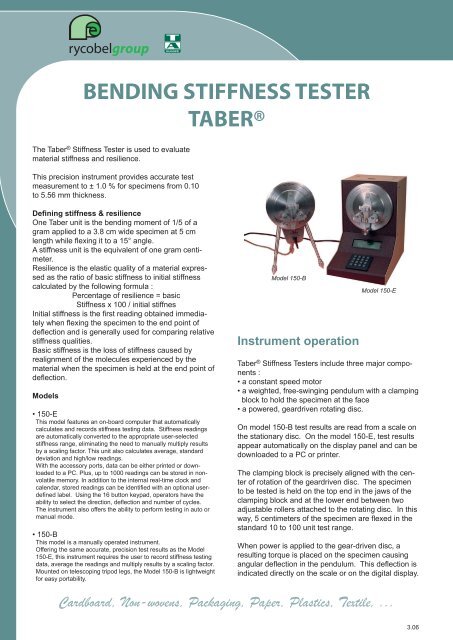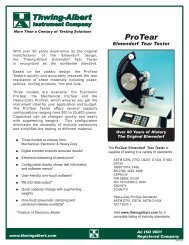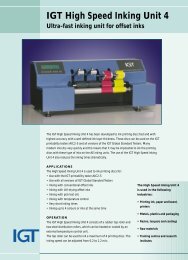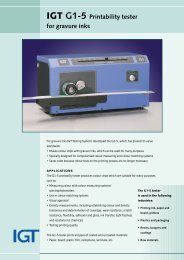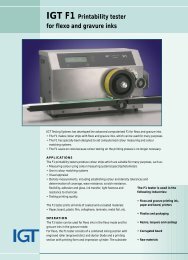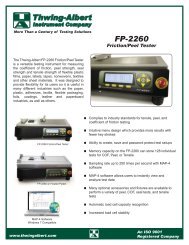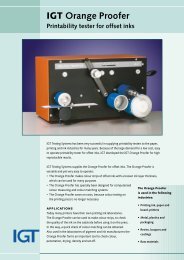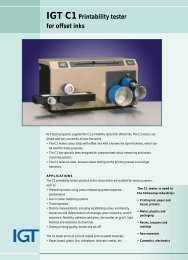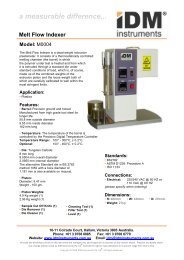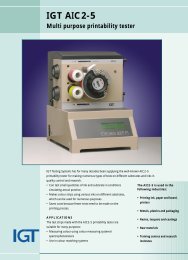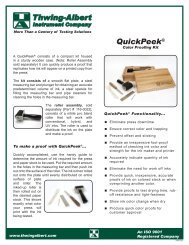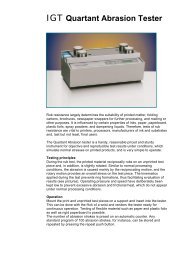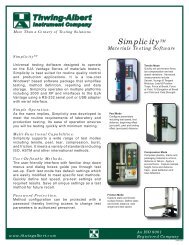BENDING STIFFNESS TESTER TABER® Cardboard ... - Regmed
BENDING STIFFNESS TESTER TABER® Cardboard ... - Regmed
BENDING STIFFNESS TESTER TABER® Cardboard ... - Regmed
Create successful ePaper yourself
Turn your PDF publications into a flip-book with our unique Google optimized e-Paper software.
<strong>BENDING</strong> <strong>STIFFNESS</strong> <strong>TESTER</strong><br />
<strong>TABER®</strong><br />
The Taber ® Stiffness Tester is used to evaluate<br />
material stiffness and resilience.<br />
This precision instrument provides accurate test<br />
measurement to ± 1.0 % for specimens from 0.10<br />
to 5.56 mm thickness.<br />
Defining stiffness & resilience<br />
One Taber unit is the bending moment of 1/5 of a<br />
gram applied to a 3.8 cm wide specimen at 5 cm<br />
length while fl exing it to a 15° angle.<br />
A stiffness unit is the equivalent of one gram centimeter.<br />
Resilience is the elastic quality of a material expressed<br />
as the ratio of basic stiffness to initial stiffness<br />
calculated by the following formula :<br />
Percentage of resilience = basic<br />
Stiffness x 100 / initial stiffnes<br />
Initial stiffness is the fi rst reading obtained immediately<br />
when fl exing the specimen to the end point of<br />
defl ection and is generally used for comparing relative<br />
stiffness qualities.<br />
Basic stiffness is the loss of stiffness caused by<br />
realignment of the molecules experienced by the<br />
material when the specimen is held at the end point of<br />
defl ection.<br />
Models<br />
• 150-E<br />
This model features an on-board computer that automatically<br />
calculates and records stiffness testing data. Stiffness readings<br />
are automatically converted to the appropriate user-selected<br />
stiffness range, eliminating the need to manually multiply results<br />
by a scaling factor. This unit also calculates average, standard<br />
deviation and high/low readings.<br />
With the accessory ports, data can be either printed or downloaded<br />
to a PC. Plus, up to 1000 readings can be stored in nonvolatile<br />
memory. In addition to the internal real-time clock and<br />
calendar, stored readings can be identifi ed with an optional userdefi<br />
ned label. Using the 16 button keypad, operators have the<br />
ability to select the direction, defl ection and number of cycles.<br />
The instrument also offers the ability to perform testing in auto or<br />
manual mode.<br />
• 150-B<br />
This model is a manually operated instrument.<br />
Offering the same accurate, precision test results as the Model<br />
150-E, this instrument requires the user to record stiffness testing<br />
data, average the readings and multiply results by a scaling factor.<br />
Mounted on telescoping tripod legs, the Model 150-B is lightweight<br />
for easy portability.<br />
Model 150-B<br />
Instrument operation<br />
Model 150-E<br />
Taber ® Stiffness Testers include three major components<br />
:<br />
• a constant speed motor<br />
• a weighted, free-swinging pendulum with a clamping<br />
block to hold the specimen at the face<br />
• a powered, geardriven rotating disc.<br />
On model 150-B test results are read from a scale on<br />
the stationary disc. On the model 150-E, test results<br />
appear automatically on the display panel and can be<br />
downloaded to a PC or printer.<br />
The clamping block is precisely aligned with the center<br />
of rotation of the geardriven disc. The specimen<br />
to be tested is held on the top end in the jaws of the<br />
clamping block and at the lower end between two<br />
adjustable rollers attached to the rotating disc. In this<br />
way, 5 centimeters of the specimen are fl exed in the<br />
standard 10 to 100 unit test range.<br />
When power is applied to the gear-driven disc, a<br />
resulting torque is placed on the specimen causing<br />
angular defl ection in the pendulum. This defl ection is<br />
indicated directly on the scale or on the digital display.<br />
<strong>Cardboard</strong>, Non-wovens, Packaging, Paper, Plastics, Textile, ...<br />
3.06
Physical specifications<br />
Dimensions<br />
150-B 42 x 22 x 25.5 cm (WxLxH)<br />
150-E 38 x 25.5 x 39 cm “<br />
Net Weight<br />
150-B 5.9 kg<br />
150-E 11.4 kg<br />
Options<br />
• Step down transformer<br />
(for model 150-B when using 230 V)<br />
• Triple cut specimen shear<br />
prepares precise samples for testing - with the interchangeable<br />
dies, you can select the appropriate size<br />
for your testing (3.8 x 3.8 or 3.8 x 7 cm)<br />
• Sensitivity range attachment<br />
for testing stiffness of extremely lightweight materials<br />
incl. cellophane, natural fi bers, synthetic fi laments,<br />
metallic foils, and more - requires the compensator<br />
range weight.<br />
• Wire/tube testing apparatus<br />
for testing cylindrical specimen materials<br />
• Range weights<br />
for testing specimens below 10 stiffness units and<br />
above 100 stiffness units<br />
• Calibration specimens<br />
• 6 mm clamp jaw upgrade<br />
used for older models stiffness testers<br />
Performance data<br />
Specimen thickness<br />
With the ratchet stop roller (included on all new instruments),<br />
the stiffness tester will accommodate specimen<br />
thickness up to 12.7 mm. However, regardless<br />
of material thickness, if your material exceeds 10000<br />
stiffness units you will need to fi nd an alternative<br />
method to test it.<br />
Testing range<br />
A set-up chart is provided with each instrument to help<br />
determine which test range should be used for the<br />
type of material being testing. When a range needs to<br />
be determined for the fi rst time, test a sample in range<br />
3. If the sample defl ects immediately and results in a<br />
very low stiffness reading of less than or equal to 10<br />
stiffness units, change to range 2. If the results are<br />
greater than or equal to 100, use ranges 4 - 9.<br />
Values of test ranges overlap. For best accuracy, test<br />
in lowest range.<br />
Operation<br />
Mechanical & electrical<br />
Power Supply<br />
115/230 V, 50/60 Hz<br />
Standards<br />
ASTM D5342, D5650, JIS P8125, ISO 2493, TAPPI<br />
T-489 os-92, T-566 om-97, ...<br />
Agent<br />
<strong>Cardboard</strong><br />
Packaging<br />
Plastics<br />
Pulp<br />
Non-wovens<br />
Paper<br />
Printing Inks<br />
Textile<br />
Nijverheidslaan 47 8540 Deerlijk Belgium<br />
Tel.: +32(0)56.78.21.70 Fax: +32(0)56.77.30.40<br />
Email: info@rycobel.be Website: www.rycobel.be


